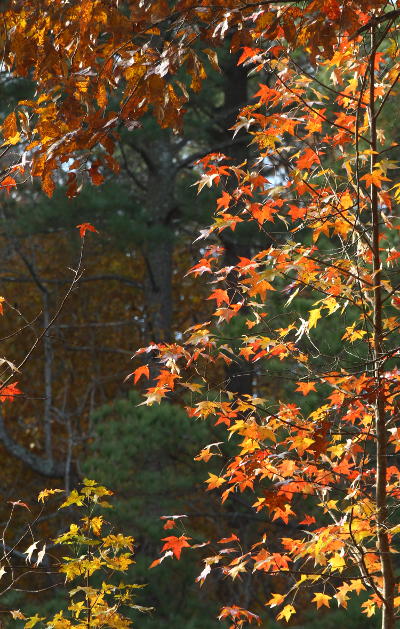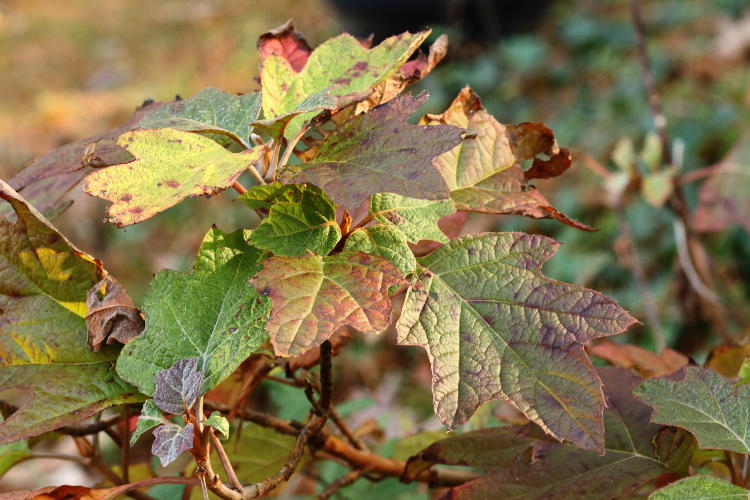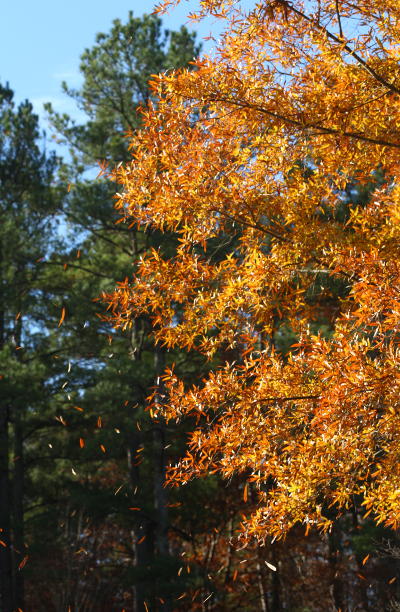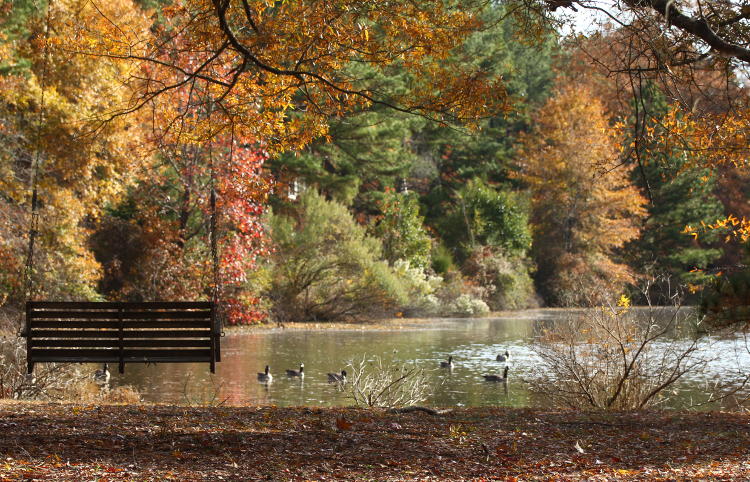
 Despite a lot of misgivings regarding the poor conditions leading up to autumn here, the colors actually developed halfway decently, and while I haven’t had a chance to go find some really nice forested areas, my local efforts have produced a pleasant showing as it is, with the potential of more to come. The droughts in late summer threatened to eradicate nearly all chances of bright colors, as trees were already turning brown and losing leaves far too early, but then we got a rainy season, several weeks of off-and-on rain, and it seems to have done the trick, so I’m adding this to my experience and predictions.
Despite a lot of misgivings regarding the poor conditions leading up to autumn here, the colors actually developed halfway decently, and while I haven’t had a chance to go find some really nice forested areas, my local efforts have produced a pleasant showing as it is, with the potential of more to come. The droughts in late summer threatened to eradicate nearly all chances of bright colors, as trees were already turning brown and losing leaves far too early, but then we got a rainy season, several weeks of off-and-on rain, and it seems to have done the trick, so I’m adding this to my experience and predictions.
Now, American sweetgum trees (Liquidambar styraciflua) can usually be counted on anyway to produce something interesting, and we have a scattering of them in the area, and as seen above and at right, they get even more vivid when backlit, with the added emphasis that when viewing from this angle, the background is often shadowed. The Girlfriend isn’t very fond of them, and I don’t blame her because the gumballs are numerous and quite annoying on a lawn, but she doesn’t spend a lot of time chasing pics, and sweetgums are photogenic little trees for the entire leaf cycle, so I take the good with the bad, provided I don’t have to sprawl across a bed of gumballs very often. You might think this is an exceptionally rare occurrence, but my shooting habits dictate otherwise; I spend a decent amount of time on the ground.
I also have to point out the performance of the oak-leaf hydrangea plants (Hydrangea quercifolia) in the yard, with a comparison from nine days ago.

Above is how they appeared on the 20th, which I found distinctive enough, but they surpassed that handily.
 Same plant, same exact branch, at only a slightly different angle, but with the benefit of the last vestiges of the rain giving some shine to the leaves. These really are cool plants, but it’s taken us a little to get them established, and they haven’t yet fleshed out a lot. Still, there will be another image coming.
Same plant, same exact branch, at only a slightly different angle, but with the benefit of the last vestiges of the rain giving some shine to the leaves. These really are cool plants, but it’s taken us a little to get them established, and they haven’t yet fleshed out a lot. Still, there will be another image coming.
 The pin oaks, or swamp Spanish oaks (Quercus palustris,) develop some okay color, nothing too vivid, but they hang onto the leaves better and longer, and provide a denser backdrop, plus we have a good selection of them around here too. Out shooting yesterday, the occasional sharp gust of wind would cause a shower of the leaves and a pleasant rustling. Which reminds me of another factor that has helped the color this year: we’ve had no fierce storms. In years past, right as the colors would have been peaking, we’ve had strong storms with very gusty winds go through, and the combination of rain and wind would strip the trees bare, but this year the rains were gentle, the winds nothing enthusiastic, so the leaves stayed put better.
The pin oaks, or swamp Spanish oaks (Quercus palustris,) develop some okay color, nothing too vivid, but they hang onto the leaves better and longer, and provide a denser backdrop, plus we have a good selection of them around here too. Out shooting yesterday, the occasional sharp gust of wind would cause a shower of the leaves and a pleasant rustling. Which reminds me of another factor that has helped the color this year: we’ve had no fierce storms. In years past, right as the colors would have been peaking, we’ve had strong storms with very gusty winds go through, and the combination of rain and wind would strip the trees bare, but this year the rains were gentle, the winds nothing enthusiastic, so the leaves stayed put better.
What you see in the background there are the hated longneedle pines that are so prevalent in the area; I find them ugly, tending to be sparse except near the tops, and of course dropping those needles everywhere. The needles themselves fall like arrows and, as light as they are, pierce easily through the leaves of other plants like the oak-leaf hydrangeas, not damaging the leaves a lot but enough to make them spotty and virtually eradicate any pristine examples that I might be after photographically. Plus it’s a constant effort to clean the needles and pinecones (very painful to step on) from the yard. In this region at least, any vista that has trees at all is likely to be liberally strewn with the pines, which keep patches of that deep green interspersed with the fall or spring colors and limiting the impact of any scenic photos you might be after.
 But here is a small trick, when you can find the conditions to exploit it. The pond’s edge was by no means bursting with color, or even a lot of trees, but when shooting down along it, the colors and foliage all compressed into a closer space, heightening the impact. To illustrate, the distance between the sweetgum (the color at the right edge of the bench) and the pin oak (the more yellow color at right center) was about fifty meters or more, with just short little trees without color change on them, but overall there’s enough in the frame to communicate the season quite well.
But here is a small trick, when you can find the conditions to exploit it. The pond’s edge was by no means bursting with color, or even a lot of trees, but when shooting down along it, the colors and foliage all compressed into a closer space, heightening the impact. To illustrate, the distance between the sweetgum (the color at the right edge of the bench) and the pin oak (the more yellow color at right center) was about fifty meters or more, with just short little trees without color change on them, but overall there’s enough in the frame to communicate the season quite well.
And I’ll close with another from the oak-leaf hydrangea – same plant, the second of two main stems. I like the pic below for the colors, but the one above for the textures. And as I said, if I get a chance at any more colors, I’ll be back later on.





















































